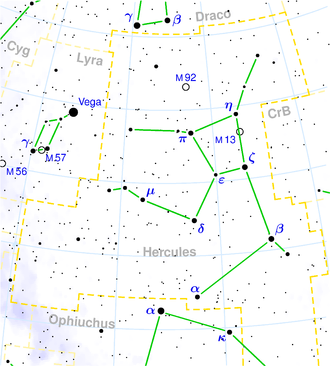NGC 6548
| Galaxy NGC 6548 |
|
|---|---|
|
|
|
| AladinLite | |
| Constellation | Hercules |
|
Position equinox : J2000.0 , epoch : J2000.0 |
|
| Right ascension | 18 h 05 m 59.2 s |
| declination | + 18 ° 35 ′ 14 ″ |
| Appearance | |
| Morphological type | SB0 |
| Brightness (visual) | 11.7 mag |
| Brightness (B-band) | 12.7 mag |
| Angular expansion | 2.9 ′ × 2.8 ′ |
| Position angle | 60 ° |
| Surface brightness | 13.8 mag / arcmin² |
| Physical data | |
| Redshift | 0.007365 +/- 0.000017 |
| Radial velocity | 2208 +/- 5 km / s |
|
Stroke distance v rad / H 0 |
(106 ± 8) · 10 6 ly (32.5 ± 2.3) Mpc |
| history | |
| discovery | Wilhelm Herschel |
| Discovery date | September 20, 1786 |
| Catalog names | |
| NGC 6548 • UGC 11115 • PGC 61404 • CGCG 113-020 • MCG + 03-46-013 • GC 4377 • H III 555 • | |
NGC 6548 is an 11.7 mag bright lenticular galaxy of the Hubble type SB0 in the constellation Hercules and about 106 million light years from the Milky Way.
It forms an optical double galaxy with the galaxy NGC 6549, which is three times further away, and was discovered on September 20, 1786 by Wilhelm Herschel with an 18.7-inch reflector telescope, who described it as "cF, S, lE, iF, resolvable" .
